Mental Health: Depression, Manifestations, and Treatment Options
VerifiedAdded on 2022/10/04
|9
|2877
|170
Report
AI Summary
This report delves into the multifaceted aspects of depression, a prevalent mental health disorder affecting millions worldwide. It begins by outlining the clinical manifestations of depression, including symptoms such as loss of interest, fatigue, and suicidal thoughts, emphasizing the challenges in diagnosis due to the absence of specific physical symptoms. The report then explores the psychopathology of depression, highlighting how various life events and stressors can contribute to its onset and impact daily life. Furthermore, it discusses the role of psychopharmacology in diagnosing and treating depression, focusing on the use of antidepressants and the ongoing research into their mechanisms of action. The report also emphasizes the importance of patient education regarding depression, its treatments, and potential side effects, as well as exploring alternative treatment options such as therapies and support groups. The report concludes by summarizing the key findings and reinforcing the importance of understanding and addressing depression through a combination of medical and therapeutic interventions.
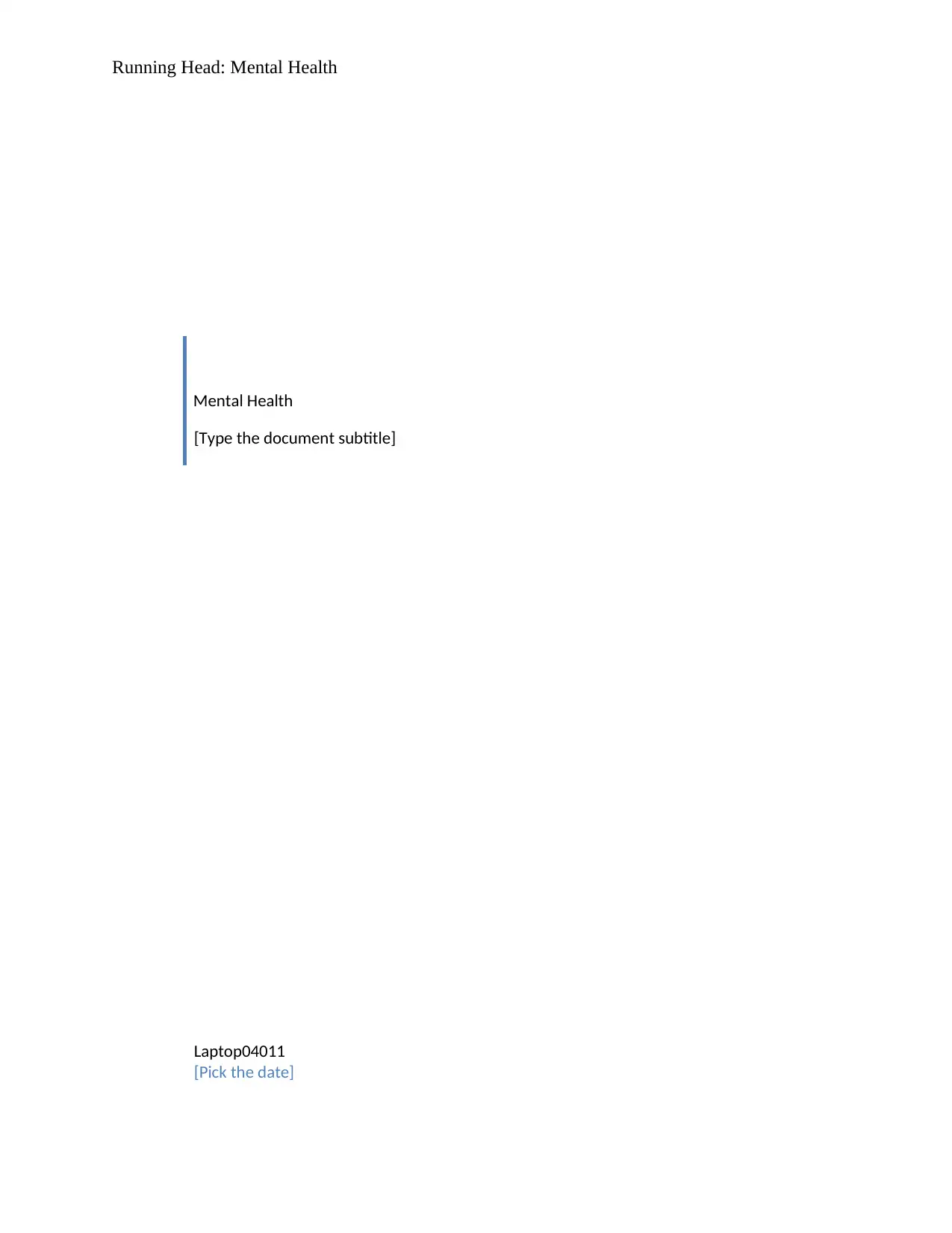
Running Head: Mental Health
Mental Health
[Type the document subtitle]
Laptop04011
[Pick the date]
Mental Health
[Type the document subtitle]
Laptop04011
[Pick the date]
Paraphrase This Document
Need a fresh take? Get an instant paraphrase of this document with our AI Paraphraser
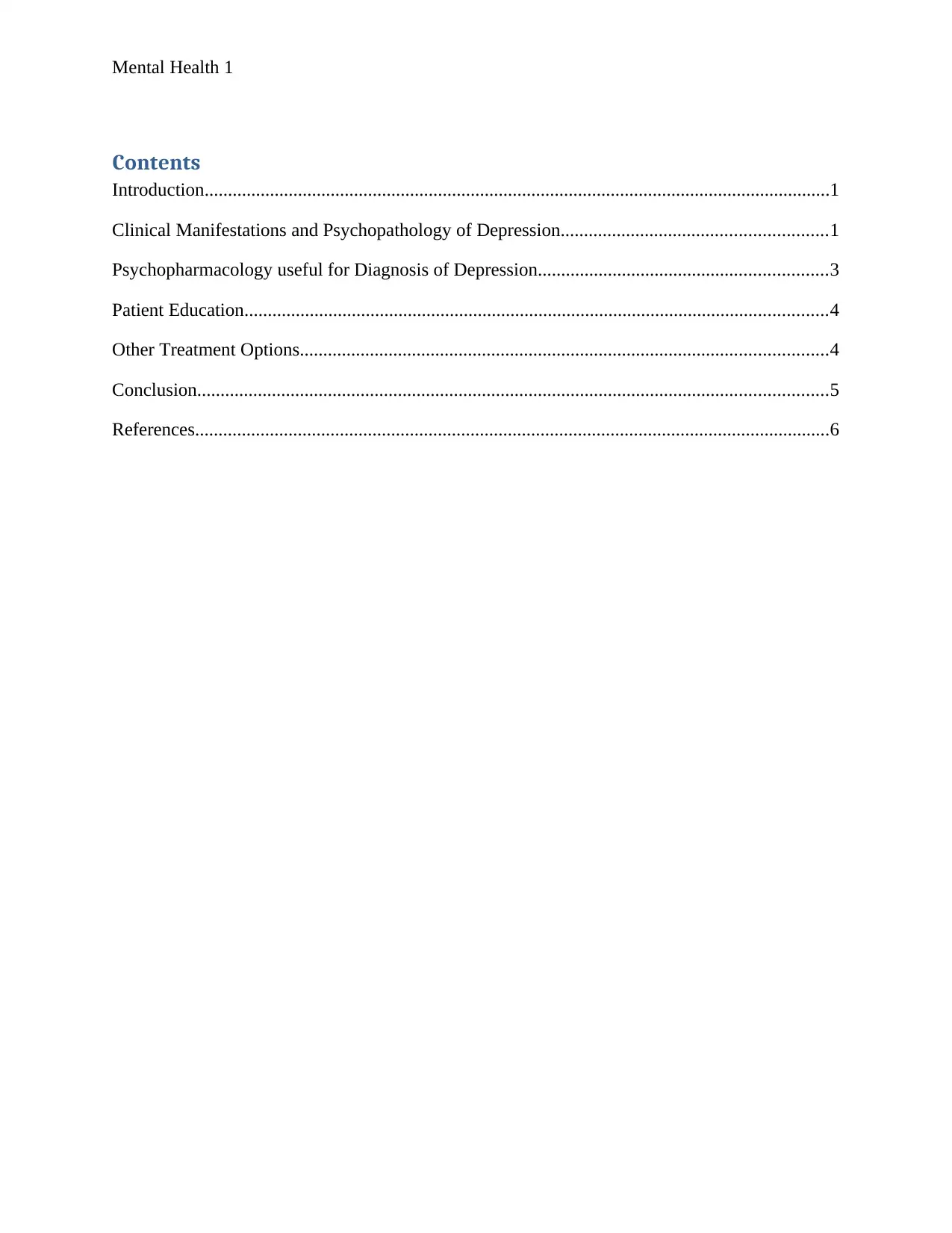
Mental Health 1
Contents
Introduction......................................................................................................................................1
Clinical Manifestations and Psychopathology of Depression.........................................................1
Psychopharmacology useful for Diagnosis of Depression..............................................................3
Patient Education.............................................................................................................................4
Other Treatment Options.................................................................................................................4
Conclusion.......................................................................................................................................5
References........................................................................................................................................6
Contents
Introduction......................................................................................................................................1
Clinical Manifestations and Psychopathology of Depression.........................................................1
Psychopharmacology useful for Diagnosis of Depression..............................................................3
Patient Education.............................................................................................................................4
Other Treatment Options.................................................................................................................4
Conclusion.......................................................................................................................................5
References........................................................................................................................................6
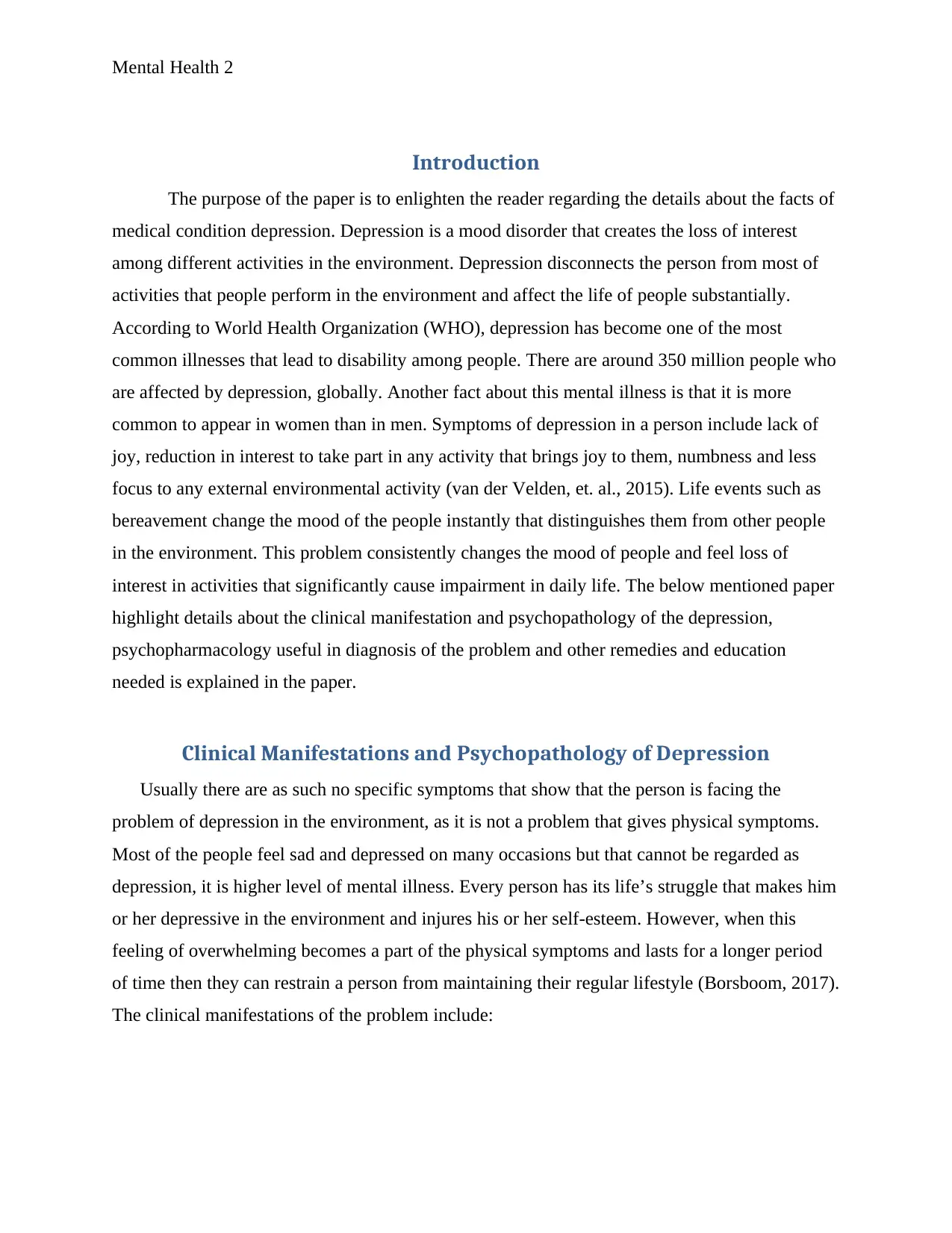
Mental Health 2
Introduction
The purpose of the paper is to enlighten the reader regarding the details about the facts of
medical condition depression. Depression is a mood disorder that creates the loss of interest
among different activities in the environment. Depression disconnects the person from most of
activities that people perform in the environment and affect the life of people substantially.
According to World Health Organization (WHO), depression has become one of the most
common illnesses that lead to disability among people. There are around 350 million people who
are affected by depression, globally. Another fact about this mental illness is that it is more
common to appear in women than in men. Symptoms of depression in a person include lack of
joy, reduction in interest to take part in any activity that brings joy to them, numbness and less
focus to any external environmental activity (van der Velden, et. al., 2015). Life events such as
bereavement change the mood of the people instantly that distinguishes them from other people
in the environment. This problem consistently changes the mood of people and feel loss of
interest in activities that significantly cause impairment in daily life. The below mentioned paper
highlight details about the clinical manifestation and psychopathology of the depression,
psychopharmacology useful in diagnosis of the problem and other remedies and education
needed is explained in the paper.
Clinical Manifestations and Psychopathology of Depression
Usually there are as such no specific symptoms that show that the person is facing the
problem of depression in the environment, as it is not a problem that gives physical symptoms.
Most of the people feel sad and depressed on many occasions but that cannot be regarded as
depression, it is higher level of mental illness. Every person has its life’s struggle that makes him
or her depressive in the environment and injures his or her self-esteem. However, when this
feeling of overwhelming becomes a part of the physical symptoms and lasts for a longer period
of time then they can restrain a person from maintaining their regular lifestyle (Borsboom, 2017).
The clinical manifestations of the problem include:
Introduction
The purpose of the paper is to enlighten the reader regarding the details about the facts of
medical condition depression. Depression is a mood disorder that creates the loss of interest
among different activities in the environment. Depression disconnects the person from most of
activities that people perform in the environment and affect the life of people substantially.
According to World Health Organization (WHO), depression has become one of the most
common illnesses that lead to disability among people. There are around 350 million people who
are affected by depression, globally. Another fact about this mental illness is that it is more
common to appear in women than in men. Symptoms of depression in a person include lack of
joy, reduction in interest to take part in any activity that brings joy to them, numbness and less
focus to any external environmental activity (van der Velden, et. al., 2015). Life events such as
bereavement change the mood of the people instantly that distinguishes them from other people
in the environment. This problem consistently changes the mood of people and feel loss of
interest in activities that significantly cause impairment in daily life. The below mentioned paper
highlight details about the clinical manifestation and psychopathology of the depression,
psychopharmacology useful in diagnosis of the problem and other remedies and education
needed is explained in the paper.
Clinical Manifestations and Psychopathology of Depression
Usually there are as such no specific symptoms that show that the person is facing the
problem of depression in the environment, as it is not a problem that gives physical symptoms.
Most of the people feel sad and depressed on many occasions but that cannot be regarded as
depression, it is higher level of mental illness. Every person has its life’s struggle that makes him
or her depressive in the environment and injures his or her self-esteem. However, when this
feeling of overwhelming becomes a part of the physical symptoms and lasts for a longer period
of time then they can restrain a person from maintaining their regular lifestyle (Borsboom, 2017).
The clinical manifestations of the problem include:
⊘ This is a preview!⊘
Do you want full access?
Subscribe today to unlock all pages.

Trusted by 1+ million students worldwide
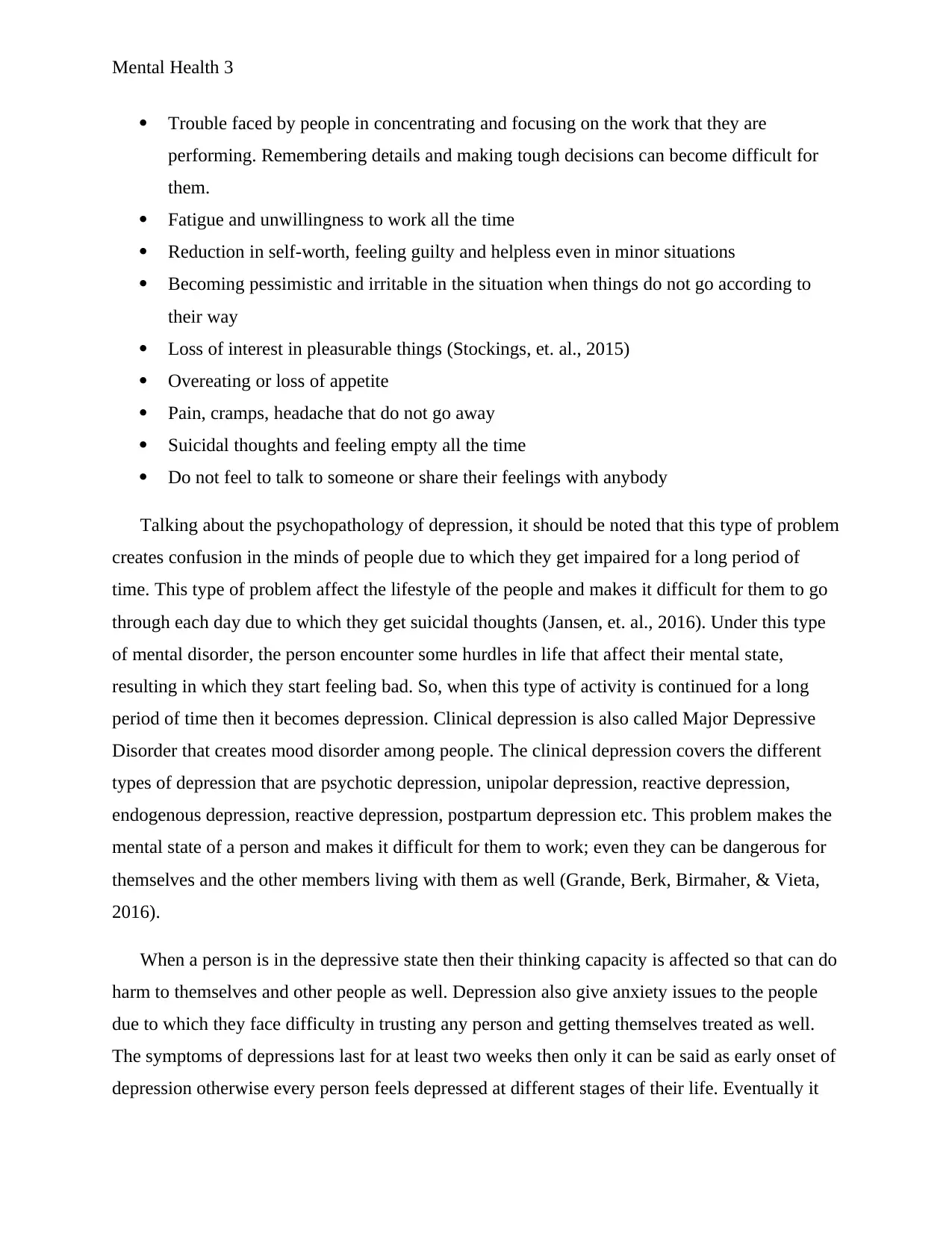
Mental Health 3
Trouble faced by people in concentrating and focusing on the work that they are
performing. Remembering details and making tough decisions can become difficult for
them.
Fatigue and unwillingness to work all the time
Reduction in self-worth, feeling guilty and helpless even in minor situations
Becoming pessimistic and irritable in the situation when things do not go according to
their way
Loss of interest in pleasurable things (Stockings, et. al., 2015)
Overeating or loss of appetite
Pain, cramps, headache that do not go away
Suicidal thoughts and feeling empty all the time
Do not feel to talk to someone or share their feelings with anybody
Talking about the psychopathology of depression, it should be noted that this type of problem
creates confusion in the minds of people due to which they get impaired for a long period of
time. This type of problem affect the lifestyle of the people and makes it difficult for them to go
through each day due to which they get suicidal thoughts (Jansen, et. al., 2016). Under this type
of mental disorder, the person encounter some hurdles in life that affect their mental state,
resulting in which they start feeling bad. So, when this type of activity is continued for a long
period of time then it becomes depression. Clinical depression is also called Major Depressive
Disorder that creates mood disorder among people. The clinical depression covers the different
types of depression that are psychotic depression, unipolar depression, reactive depression,
endogenous depression, reactive depression, postpartum depression etc. This problem makes the
mental state of a person and makes it difficult for them to work; even they can be dangerous for
themselves and the other members living with them as well (Grande, Berk, Birmaher, & Vieta,
2016).
When a person is in the depressive state then their thinking capacity is affected so that can do
harm to themselves and other people as well. Depression also give anxiety issues to the people
due to which they face difficulty in trusting any person and getting themselves treated as well.
The symptoms of depressions last for at least two weeks then only it can be said as early onset of
depression otherwise every person feels depressed at different stages of their life. Eventually it
Trouble faced by people in concentrating and focusing on the work that they are
performing. Remembering details and making tough decisions can become difficult for
them.
Fatigue and unwillingness to work all the time
Reduction in self-worth, feeling guilty and helpless even in minor situations
Becoming pessimistic and irritable in the situation when things do not go according to
their way
Loss of interest in pleasurable things (Stockings, et. al., 2015)
Overeating or loss of appetite
Pain, cramps, headache that do not go away
Suicidal thoughts and feeling empty all the time
Do not feel to talk to someone or share their feelings with anybody
Talking about the psychopathology of depression, it should be noted that this type of problem
creates confusion in the minds of people due to which they get impaired for a long period of
time. This type of problem affect the lifestyle of the people and makes it difficult for them to go
through each day due to which they get suicidal thoughts (Jansen, et. al., 2016). Under this type
of mental disorder, the person encounter some hurdles in life that affect their mental state,
resulting in which they start feeling bad. So, when this type of activity is continued for a long
period of time then it becomes depression. Clinical depression is also called Major Depressive
Disorder that creates mood disorder among people. The clinical depression covers the different
types of depression that are psychotic depression, unipolar depression, reactive depression,
endogenous depression, reactive depression, postpartum depression etc. This problem makes the
mental state of a person and makes it difficult for them to work; even they can be dangerous for
themselves and the other members living with them as well (Grande, Berk, Birmaher, & Vieta,
2016).
When a person is in the depressive state then their thinking capacity is affected so that can do
harm to themselves and other people as well. Depression also give anxiety issues to the people
due to which they face difficulty in trusting any person and getting themselves treated as well.
The symptoms of depressions last for at least two weeks then only it can be said as early onset of
depression otherwise every person feels depressed at different stages of their life. Eventually it
Paraphrase This Document
Need a fresh take? Get an instant paraphrase of this document with our AI Paraphraser
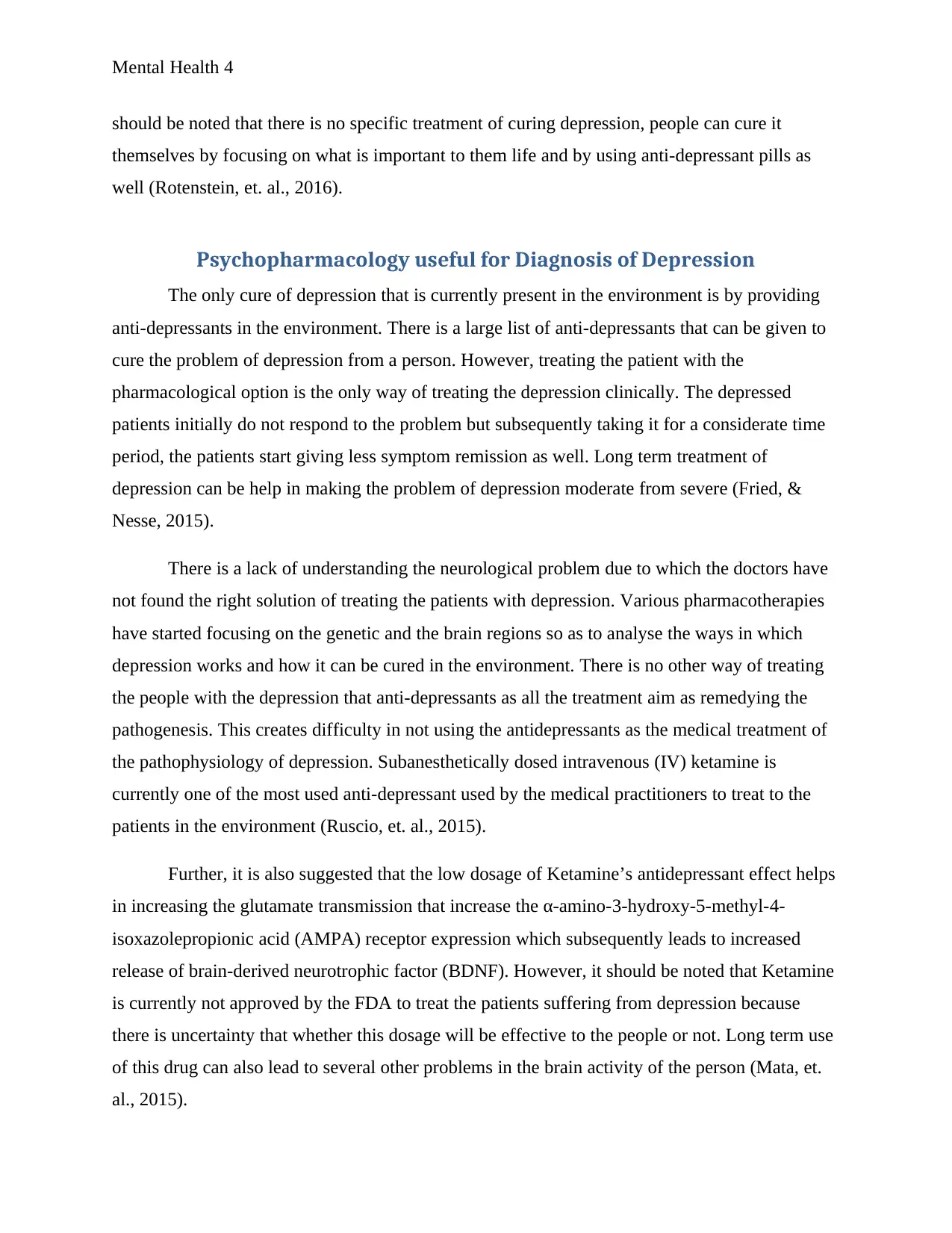
Mental Health 4
should be noted that there is no specific treatment of curing depression, people can cure it
themselves by focusing on what is important to them life and by using anti-depressant pills as
well (Rotenstein, et. al., 2016).
Psychopharmacology useful for Diagnosis of Depression
The only cure of depression that is currently present in the environment is by providing
anti-depressants in the environment. There is a large list of anti-depressants that can be given to
cure the problem of depression from a person. However, treating the patient with the
pharmacological option is the only way of treating the depression clinically. The depressed
patients initially do not respond to the problem but subsequently taking it for a considerate time
period, the patients start giving less symptom remission as well. Long term treatment of
depression can be help in making the problem of depression moderate from severe (Fried, &
Nesse, 2015).
There is a lack of understanding the neurological problem due to which the doctors have
not found the right solution of treating the patients with depression. Various pharmacotherapies
have started focusing on the genetic and the brain regions so as to analyse the ways in which
depression works and how it can be cured in the environment. There is no other way of treating
the people with the depression that anti-depressants as all the treatment aim as remedying the
pathogenesis. This creates difficulty in not using the antidepressants as the medical treatment of
the pathophysiology of depression. Subanesthetically dosed intravenous (IV) ketamine is
currently one of the most used anti-depressant used by the medical practitioners to treat to the
patients in the environment (Ruscio, et. al., 2015).
Further, it is also suggested that the low dosage of Ketamine’s antidepressant effect helps
in increasing the glutamate transmission that increase the α-amino-3-hydroxy-5-methyl-4-
isoxazolepropionic acid (AMPA) receptor expression which subsequently leads to increased
release of brain-derived neurotrophic factor (BDNF). However, it should be noted that Ketamine
is currently not approved by the FDA to treat the patients suffering from depression because
there is uncertainty that whether this dosage will be effective to the people or not. Long term use
of this drug can also lead to several other problems in the brain activity of the person (Mata, et.
al., 2015).
should be noted that there is no specific treatment of curing depression, people can cure it
themselves by focusing on what is important to them life and by using anti-depressant pills as
well (Rotenstein, et. al., 2016).
Psychopharmacology useful for Diagnosis of Depression
The only cure of depression that is currently present in the environment is by providing
anti-depressants in the environment. There is a large list of anti-depressants that can be given to
cure the problem of depression from a person. However, treating the patient with the
pharmacological option is the only way of treating the depression clinically. The depressed
patients initially do not respond to the problem but subsequently taking it for a considerate time
period, the patients start giving less symptom remission as well. Long term treatment of
depression can be help in making the problem of depression moderate from severe (Fried, &
Nesse, 2015).
There is a lack of understanding the neurological problem due to which the doctors have
not found the right solution of treating the patients with depression. Various pharmacotherapies
have started focusing on the genetic and the brain regions so as to analyse the ways in which
depression works and how it can be cured in the environment. There is no other way of treating
the people with the depression that anti-depressants as all the treatment aim as remedying the
pathogenesis. This creates difficulty in not using the antidepressants as the medical treatment of
the pathophysiology of depression. Subanesthetically dosed intravenous (IV) ketamine is
currently one of the most used anti-depressant used by the medical practitioners to treat to the
patients in the environment (Ruscio, et. al., 2015).
Further, it is also suggested that the low dosage of Ketamine’s antidepressant effect helps
in increasing the glutamate transmission that increase the α-amino-3-hydroxy-5-methyl-4-
isoxazolepropionic acid (AMPA) receptor expression which subsequently leads to increased
release of brain-derived neurotrophic factor (BDNF). However, it should be noted that Ketamine
is currently not approved by the FDA to treat the patients suffering from depression because
there is uncertainty that whether this dosage will be effective to the people or not. Long term use
of this drug can also lead to several other problems in the brain activity of the person (Mata, et.
al., 2015).
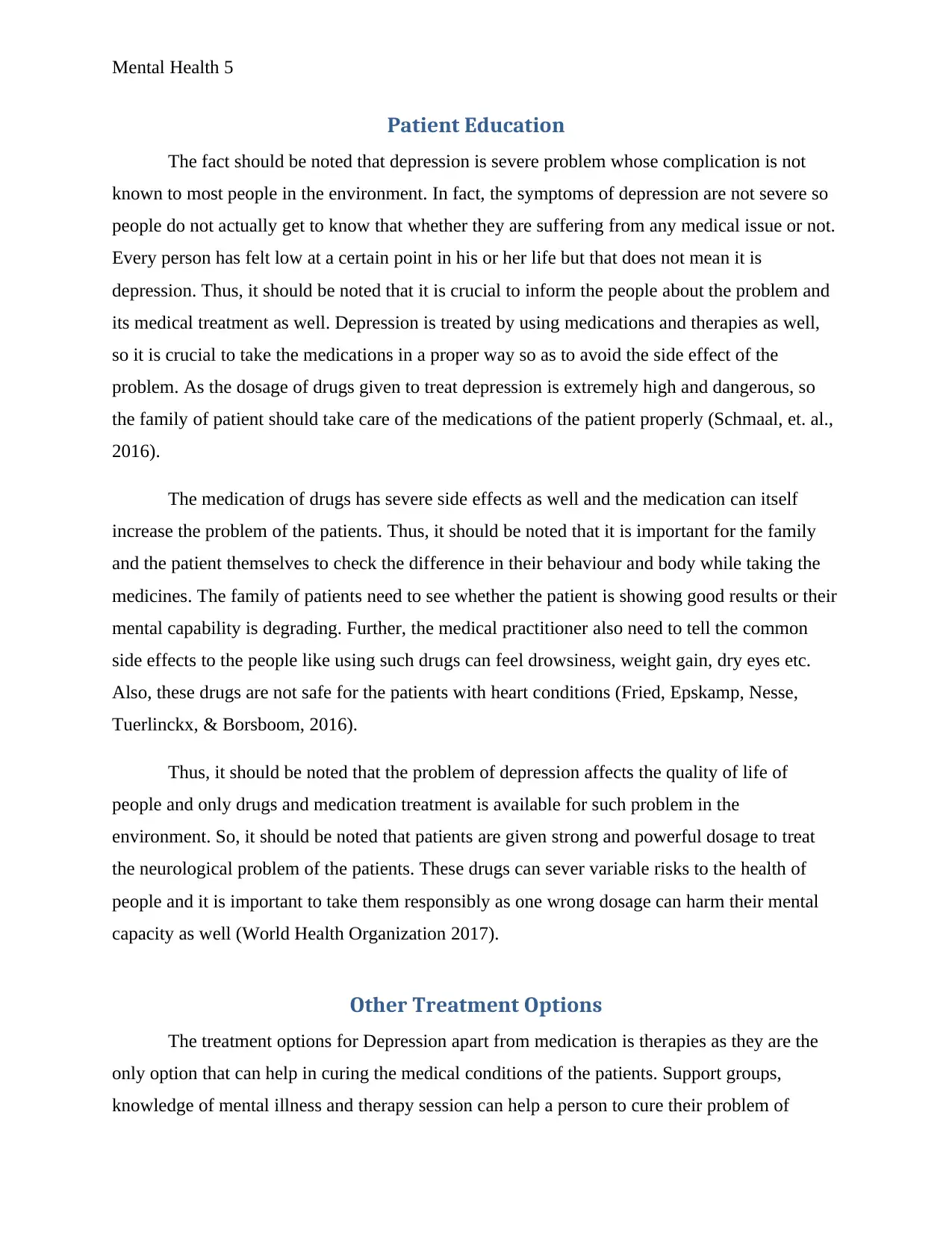
Mental Health 5
Patient Education
The fact should be noted that depression is severe problem whose complication is not
known to most people in the environment. In fact, the symptoms of depression are not severe so
people do not actually get to know that whether they are suffering from any medical issue or not.
Every person has felt low at a certain point in his or her life but that does not mean it is
depression. Thus, it should be noted that it is crucial to inform the people about the problem and
its medical treatment as well. Depression is treated by using medications and therapies as well,
so it is crucial to take the medications in a proper way so as to avoid the side effect of the
problem. As the dosage of drugs given to treat depression is extremely high and dangerous, so
the family of patient should take care of the medications of the patient properly (Schmaal, et. al.,
2016).
The medication of drugs has severe side effects as well and the medication can itself
increase the problem of the patients. Thus, it should be noted that it is important for the family
and the patient themselves to check the difference in their behaviour and body while taking the
medicines. The family of patients need to see whether the patient is showing good results or their
mental capability is degrading. Further, the medical practitioner also need to tell the common
side effects to the people like using such drugs can feel drowsiness, weight gain, dry eyes etc.
Also, these drugs are not safe for the patients with heart conditions (Fried, Epskamp, Nesse,
Tuerlinckx, & Borsboom, 2016).
Thus, it should be noted that the problem of depression affects the quality of life of
people and only drugs and medication treatment is available for such problem in the
environment. So, it should be noted that patients are given strong and powerful dosage to treat
the neurological problem of the patients. These drugs can sever variable risks to the health of
people and it is important to take them responsibly as one wrong dosage can harm their mental
capacity as well (World Health Organization 2017).
Other Treatment Options
The treatment options for Depression apart from medication is therapies as they are the
only option that can help in curing the medical conditions of the patients. Support groups,
knowledge of mental illness and therapy session can help a person to cure their problem of
Patient Education
The fact should be noted that depression is severe problem whose complication is not
known to most people in the environment. In fact, the symptoms of depression are not severe so
people do not actually get to know that whether they are suffering from any medical issue or not.
Every person has felt low at a certain point in his or her life but that does not mean it is
depression. Thus, it should be noted that it is crucial to inform the people about the problem and
its medical treatment as well. Depression is treated by using medications and therapies as well,
so it is crucial to take the medications in a proper way so as to avoid the side effect of the
problem. As the dosage of drugs given to treat depression is extremely high and dangerous, so
the family of patient should take care of the medications of the patient properly (Schmaal, et. al.,
2016).
The medication of drugs has severe side effects as well and the medication can itself
increase the problem of the patients. Thus, it should be noted that it is important for the family
and the patient themselves to check the difference in their behaviour and body while taking the
medicines. The family of patients need to see whether the patient is showing good results or their
mental capability is degrading. Further, the medical practitioner also need to tell the common
side effects to the people like using such drugs can feel drowsiness, weight gain, dry eyes etc.
Also, these drugs are not safe for the patients with heart conditions (Fried, Epskamp, Nesse,
Tuerlinckx, & Borsboom, 2016).
Thus, it should be noted that the problem of depression affects the quality of life of
people and only drugs and medication treatment is available for such problem in the
environment. So, it should be noted that patients are given strong and powerful dosage to treat
the neurological problem of the patients. These drugs can sever variable risks to the health of
people and it is important to take them responsibly as one wrong dosage can harm their mental
capacity as well (World Health Organization 2017).
Other Treatment Options
The treatment options for Depression apart from medication is therapies as they are the
only option that can help in curing the medical conditions of the patients. Support groups,
knowledge of mental illness and therapy session can help a person to cure their problem of
⊘ This is a preview!⊘
Do you want full access?
Subscribe today to unlock all pages.

Trusted by 1+ million students worldwide
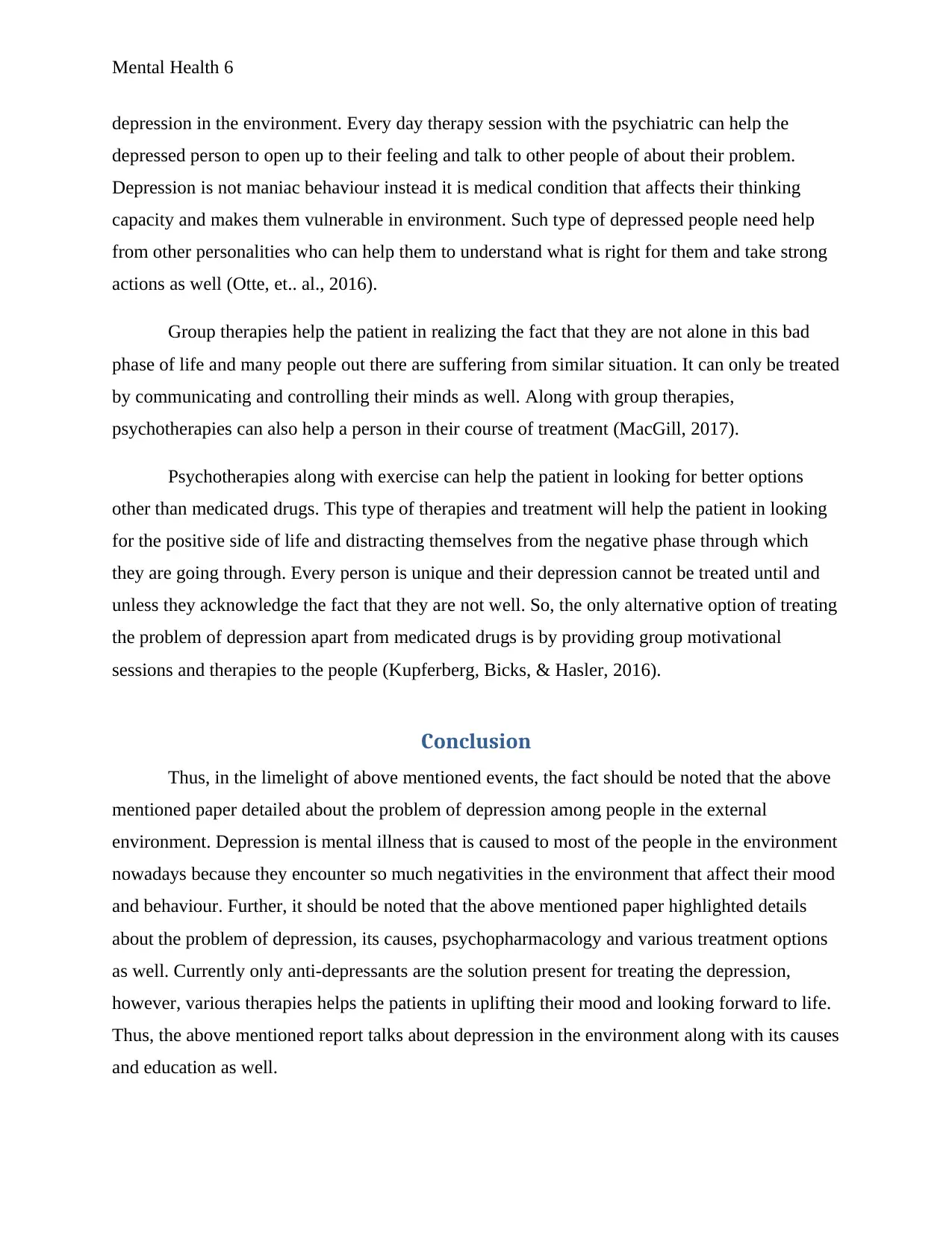
Mental Health 6
depression in the environment. Every day therapy session with the psychiatric can help the
depressed person to open up to their feeling and talk to other people of about their problem.
Depression is not maniac behaviour instead it is medical condition that affects their thinking
capacity and makes them vulnerable in environment. Such type of depressed people need help
from other personalities who can help them to understand what is right for them and take strong
actions as well (Otte, et.. al., 2016).
Group therapies help the patient in realizing the fact that they are not alone in this bad
phase of life and many people out there are suffering from similar situation. It can only be treated
by communicating and controlling their minds as well. Along with group therapies,
psychotherapies can also help a person in their course of treatment (MacGill, 2017).
Psychotherapies along with exercise can help the patient in looking for better options
other than medicated drugs. This type of therapies and treatment will help the patient in looking
for the positive side of life and distracting themselves from the negative phase through which
they are going through. Every person is unique and their depression cannot be treated until and
unless they acknowledge the fact that they are not well. So, the only alternative option of treating
the problem of depression apart from medicated drugs is by providing group motivational
sessions and therapies to the people (Kupferberg, Bicks, & Hasler, 2016).
Conclusion
Thus, in the limelight of above mentioned events, the fact should be noted that the above
mentioned paper detailed about the problem of depression among people in the external
environment. Depression is mental illness that is caused to most of the people in the environment
nowadays because they encounter so much negativities in the environment that affect their mood
and behaviour. Further, it should be noted that the above mentioned paper highlighted details
about the problem of depression, its causes, psychopharmacology and various treatment options
as well. Currently only anti-depressants are the solution present for treating the depression,
however, various therapies helps the patients in uplifting their mood and looking forward to life.
Thus, the above mentioned report talks about depression in the environment along with its causes
and education as well.
depression in the environment. Every day therapy session with the psychiatric can help the
depressed person to open up to their feeling and talk to other people of about their problem.
Depression is not maniac behaviour instead it is medical condition that affects their thinking
capacity and makes them vulnerable in environment. Such type of depressed people need help
from other personalities who can help them to understand what is right for them and take strong
actions as well (Otte, et.. al., 2016).
Group therapies help the patient in realizing the fact that they are not alone in this bad
phase of life and many people out there are suffering from similar situation. It can only be treated
by communicating and controlling their minds as well. Along with group therapies,
psychotherapies can also help a person in their course of treatment (MacGill, 2017).
Psychotherapies along with exercise can help the patient in looking for better options
other than medicated drugs. This type of therapies and treatment will help the patient in looking
for the positive side of life and distracting themselves from the negative phase through which
they are going through. Every person is unique and their depression cannot be treated until and
unless they acknowledge the fact that they are not well. So, the only alternative option of treating
the problem of depression apart from medicated drugs is by providing group motivational
sessions and therapies to the people (Kupferberg, Bicks, & Hasler, 2016).
Conclusion
Thus, in the limelight of above mentioned events, the fact should be noted that the above
mentioned paper detailed about the problem of depression among people in the external
environment. Depression is mental illness that is caused to most of the people in the environment
nowadays because they encounter so much negativities in the environment that affect their mood
and behaviour. Further, it should be noted that the above mentioned paper highlighted details
about the problem of depression, its causes, psychopharmacology and various treatment options
as well. Currently only anti-depressants are the solution present for treating the depression,
however, various therapies helps the patients in uplifting their mood and looking forward to life.
Thus, the above mentioned report talks about depression in the environment along with its causes
and education as well.
Paraphrase This Document
Need a fresh take? Get an instant paraphrase of this document with our AI Paraphraser
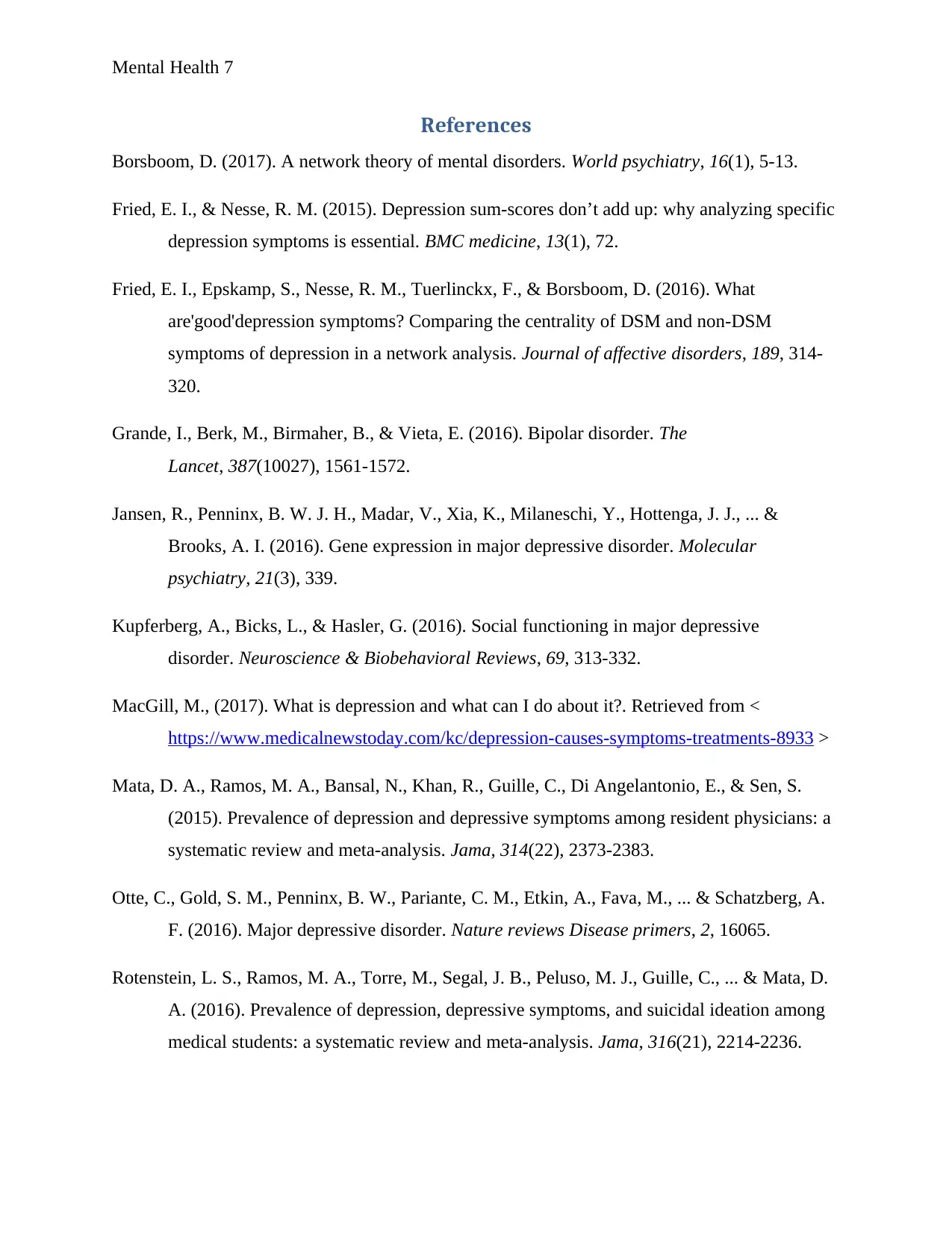
Mental Health 7
References
Borsboom, D. (2017). A network theory of mental disorders. World psychiatry, 16(1), 5-13.
Fried, E. I., & Nesse, R. M. (2015). Depression sum-scores don’t add up: why analyzing specific
depression symptoms is essential. BMC medicine, 13(1), 72.
Fried, E. I., Epskamp, S., Nesse, R. M., Tuerlinckx, F., & Borsboom, D. (2016). What
are'good'depression symptoms? Comparing the centrality of DSM and non-DSM
symptoms of depression in a network analysis. Journal of affective disorders, 189, 314-
320.
Grande, I., Berk, M., Birmaher, B., & Vieta, E. (2016). Bipolar disorder. The
Lancet, 387(10027), 1561-1572.
Jansen, R., Penninx, B. W. J. H., Madar, V., Xia, K., Milaneschi, Y., Hottenga, J. J., ... &
Brooks, A. I. (2016). Gene expression in major depressive disorder. Molecular
psychiatry, 21(3), 339.
Kupferberg, A., Bicks, L., & Hasler, G. (2016). Social functioning in major depressive
disorder. Neuroscience & Biobehavioral Reviews, 69, 313-332.
MacGill, M., (2017). What is depression and what can I do about it?. Retrieved from <
https://www.medicalnewstoday.com/kc/depression-causes-symptoms-treatments-8933 >
Mata, D. A., Ramos, M. A., Bansal, N., Khan, R., Guille, C., Di Angelantonio, E., & Sen, S.
(2015). Prevalence of depression and depressive symptoms among resident physicians: a
systematic review and meta-analysis. Jama, 314(22), 2373-2383.
Otte, C., Gold, S. M., Penninx, B. W., Pariante, C. M., Etkin, A., Fava, M., ... & Schatzberg, A.
F. (2016). Major depressive disorder. Nature reviews Disease primers, 2, 16065.
Rotenstein, L. S., Ramos, M. A., Torre, M., Segal, J. B., Peluso, M. J., Guille, C., ... & Mata, D.
A. (2016). Prevalence of depression, depressive symptoms, and suicidal ideation among
medical students: a systematic review and meta-analysis. Jama, 316(21), 2214-2236.
References
Borsboom, D. (2017). A network theory of mental disorders. World psychiatry, 16(1), 5-13.
Fried, E. I., & Nesse, R. M. (2015). Depression sum-scores don’t add up: why analyzing specific
depression symptoms is essential. BMC medicine, 13(1), 72.
Fried, E. I., Epskamp, S., Nesse, R. M., Tuerlinckx, F., & Borsboom, D. (2016). What
are'good'depression symptoms? Comparing the centrality of DSM and non-DSM
symptoms of depression in a network analysis. Journal of affective disorders, 189, 314-
320.
Grande, I., Berk, M., Birmaher, B., & Vieta, E. (2016). Bipolar disorder. The
Lancet, 387(10027), 1561-1572.
Jansen, R., Penninx, B. W. J. H., Madar, V., Xia, K., Milaneschi, Y., Hottenga, J. J., ... &
Brooks, A. I. (2016). Gene expression in major depressive disorder. Molecular
psychiatry, 21(3), 339.
Kupferberg, A., Bicks, L., & Hasler, G. (2016). Social functioning in major depressive
disorder. Neuroscience & Biobehavioral Reviews, 69, 313-332.
MacGill, M., (2017). What is depression and what can I do about it?. Retrieved from <
https://www.medicalnewstoday.com/kc/depression-causes-symptoms-treatments-8933 >
Mata, D. A., Ramos, M. A., Bansal, N., Khan, R., Guille, C., Di Angelantonio, E., & Sen, S.
(2015). Prevalence of depression and depressive symptoms among resident physicians: a
systematic review and meta-analysis. Jama, 314(22), 2373-2383.
Otte, C., Gold, S. M., Penninx, B. W., Pariante, C. M., Etkin, A., Fava, M., ... & Schatzberg, A.
F. (2016). Major depressive disorder. Nature reviews Disease primers, 2, 16065.
Rotenstein, L. S., Ramos, M. A., Torre, M., Segal, J. B., Peluso, M. J., Guille, C., ... & Mata, D.
A. (2016). Prevalence of depression, depressive symptoms, and suicidal ideation among
medical students: a systematic review and meta-analysis. Jama, 316(21), 2214-2236.
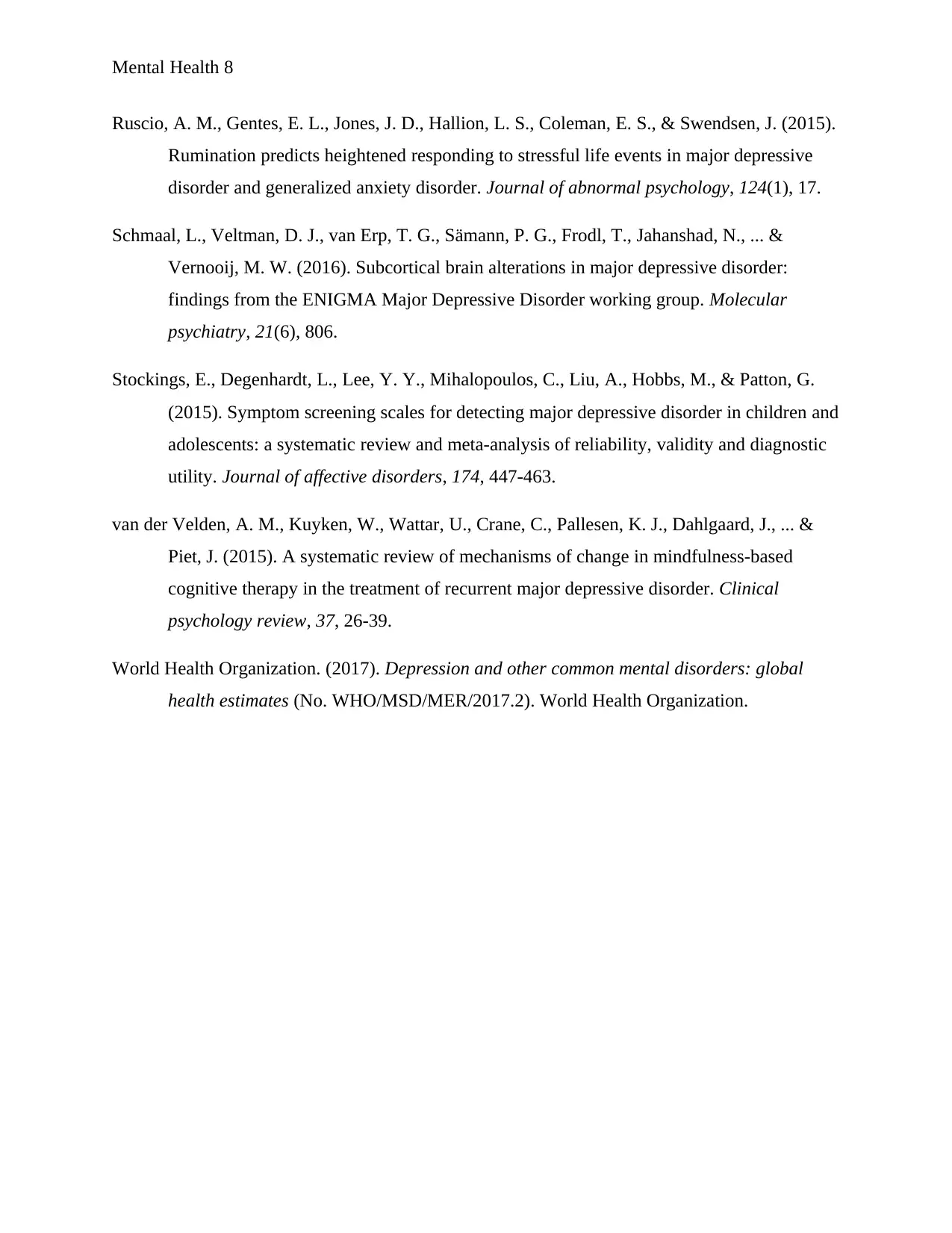
Mental Health 8
Ruscio, A. M., Gentes, E. L., Jones, J. D., Hallion, L. S., Coleman, E. S., & Swendsen, J. (2015).
Rumination predicts heightened responding to stressful life events in major depressive
disorder and generalized anxiety disorder. Journal of abnormal psychology, 124(1), 17.
Schmaal, L., Veltman, D. J., van Erp, T. G., Sämann, P. G., Frodl, T., Jahanshad, N., ... &
Vernooij, M. W. (2016). Subcortical brain alterations in major depressive disorder:
findings from the ENIGMA Major Depressive Disorder working group. Molecular
psychiatry, 21(6), 806.
Stockings, E., Degenhardt, L., Lee, Y. Y., Mihalopoulos, C., Liu, A., Hobbs, M., & Patton, G.
(2015). Symptom screening scales for detecting major depressive disorder in children and
adolescents: a systematic review and meta-analysis of reliability, validity and diagnostic
utility. Journal of affective disorders, 174, 447-463.
van der Velden, A. M., Kuyken, W., Wattar, U., Crane, C., Pallesen, K. J., Dahlgaard, J., ... &
Piet, J. (2015). A systematic review of mechanisms of change in mindfulness-based
cognitive therapy in the treatment of recurrent major depressive disorder. Clinical
psychology review, 37, 26-39.
World Health Organization. (2017). Depression and other common mental disorders: global
health estimates (No. WHO/MSD/MER/2017.2). World Health Organization.
Ruscio, A. M., Gentes, E. L., Jones, J. D., Hallion, L. S., Coleman, E. S., & Swendsen, J. (2015).
Rumination predicts heightened responding to stressful life events in major depressive
disorder and generalized anxiety disorder. Journal of abnormal psychology, 124(1), 17.
Schmaal, L., Veltman, D. J., van Erp, T. G., Sämann, P. G., Frodl, T., Jahanshad, N., ... &
Vernooij, M. W. (2016). Subcortical brain alterations in major depressive disorder:
findings from the ENIGMA Major Depressive Disorder working group. Molecular
psychiatry, 21(6), 806.
Stockings, E., Degenhardt, L., Lee, Y. Y., Mihalopoulos, C., Liu, A., Hobbs, M., & Patton, G.
(2015). Symptom screening scales for detecting major depressive disorder in children and
adolescents: a systematic review and meta-analysis of reliability, validity and diagnostic
utility. Journal of affective disorders, 174, 447-463.
van der Velden, A. M., Kuyken, W., Wattar, U., Crane, C., Pallesen, K. J., Dahlgaard, J., ... &
Piet, J. (2015). A systematic review of mechanisms of change in mindfulness-based
cognitive therapy in the treatment of recurrent major depressive disorder. Clinical
psychology review, 37, 26-39.
World Health Organization. (2017). Depression and other common mental disorders: global
health estimates (No. WHO/MSD/MER/2017.2). World Health Organization.
⊘ This is a preview!⊘
Do you want full access?
Subscribe today to unlock all pages.

Trusted by 1+ million students worldwide
1 out of 9
Related Documents
Your All-in-One AI-Powered Toolkit for Academic Success.
+13062052269
info@desklib.com
Available 24*7 on WhatsApp / Email
![[object Object]](/_next/static/media/star-bottom.7253800d.svg)
Unlock your academic potential
Copyright © 2020–2025 A2Z Services. All Rights Reserved. Developed and managed by ZUCOL.





